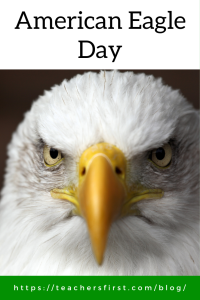The bald eagle is a magnificent creature that holds a special place in American history and culture; this symbol of freedom and strength has made a remarkable recovery from the brink of extinction and is now thriving in many parts of the United States. In recognition of this symbol of freedom, June 20th is recognized as American Eagle Day.
Many resources are available to share with students to learn about and observe American eagles, including live cams, virtual visits to native habitats, and national parks. Each resource enhances students’ learning experiences by offering information from different perspectives.
Live Cams:
Live cams are among the most exciting ways to engage students in learning about bald eagles. Many organizations and national parks across the United States have live cams near bald eagle nests, allowing students to observe these birds in their natural habitats. These live cams provide a unique and up-close experience for students to witness bald eagles in action, from nesting to feeding their young. In addition, students have opportunities to observe the eagles’ behaviors, such as hunting, feeding, and interacting with their offspring, which can spark discussions and research opportunities.
Consider adding a link to several webcams on classroom computers for students to observe throughout the day. Here are some suggestions to get started:
- Decorah Bald Eagles, Iowa
- Channel Islands Live Bald Eagle Cam, California
- American Eagle Foundation webcams from several locations
Native Habitats:
Teaching students about the native habitats of bald eagles is essential to develop an understanding of their ecology and conservation. Bald eagles are found in diverse habitats across the United States, including coastal areas, lakes, rivers, and forests. They require large trees for nesting, access to water bodies for hunting, and open spaces for soaring. Incorporating discussions about the importance of habitat preservation and the impact of human activities on eagle habitats helps to raise student awareness about the need for conservation efforts. Use resources such as maps, diagrams, and videos to illustrate the different habitats where bald eagles can be found in the United States. These links share resources about native habitats:
- Bald Eagle Range and Sighting Maps
- National Geographic Kids: Bald Eagles
- U.S. Fish and Wildlife Service: Bald Eagle Fact Sheet
National Parks:
National parks in the United States play a critical role in protecting and conserving bald eagles and their habitats. Many national parks offer designated areas for eagle watching and provide excellent opportunities for students to learn about these birds in their natural environment. Visiting the websites of national parks offers valuable educational resources that include educational materials, lesson plans, and ranger-led programs related to bald eagles. In addition, some of these sites include information about the history of the bald eagle as a national symbol and its significance to American culture. These national parks websites offer bald eagle educational resources:
- Glacier National Park, Montana
- Voyageurs National Park, Minnesota
- Get a first-hand look inside a bald eagle’s next from this video by the National Park Service.
Research:
Research allows students to develop critical thinking skills, gather information from reliable sources, and deepen their understanding of these magnificent birds. Assign research projects on various topics related to bald eagles, such as their biology, behavior, life cycle, threats, conservation efforts, and cultural significance. To conduct their research, offer students a variety of resources, including books, articles, websites, and scientific journals. This is also an excellent opportunity to teach lessons on evaluating sources for credibility and accuracy. Encourage students to present their findings through presentations, posters, or written reports to enhance their learning experience and promote communication skills.
- The U.S. Fish and Wildlife Service (USFWS) is the federal agency responsible for conserving and managing bald eagles in the United States. Their website provides a wealth of information about bald eagles, including their biology, behavior, habitat, conservation status, and recovery efforts. This site also includes fact sheets, educational materials, and scientific reports from the USFWS website, which can serve as authoritative sources for their research.
- eBird contains extensive resources for learning about bald eagles. In addition to identification information, view statistics on bald eagle observations, including images and audio. Other options allow users to select a region to view a bar chart showing weekly sightings or watch video observations of bald eagles from around the country.
- The Cornell Lab of Ornithology is a leading institution in ornithology, the study of birds. Their website offers impressive information about bald eagles, including biology, behavior, identification, and distribution. Also, users can access online courses, multimedia resources, and scientific publications related to bald eagles on the Cornell Lab of Ornithology’s website, which can serve as reputable sources for their research.
American Eagle Day provides a unique opportunity for educators to inspire their students to appreciate and learn about the beauty and importance of bald eagles. Incorporating live cams, native habitats, and national parks and research into your classroom curriculum helps students better understand these majestic birds and their significance to American culture and conservation efforts. As a bonus, fostering a sense of curiosity and appreciation for bald eagles promotes a lifelong love for nature and a desire to protect and conserve our natural heritage.
Happy American Eagle Day! Do you have suggestions and resources that enhance learning opportunities to share in the comments below? We always enjoy learning together with our readers!


